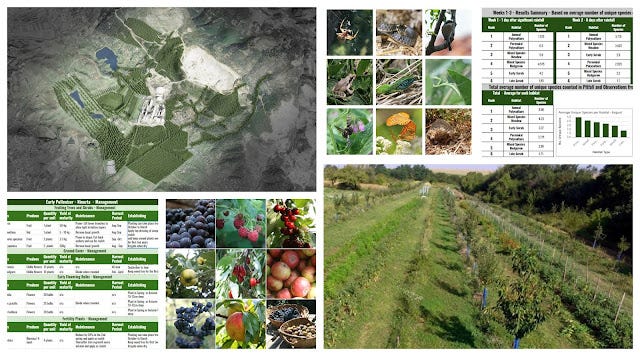The purpose of the garden is to produce fruits and perennial vegetables with all fertility, to support growth, produced within the garden (beyond initial set-up inputs.), and to provide a range of habitats to support wildlife.
Our goal was to encourage the existing biodiversity as much as possible and provide new habitat that would enhance the diversity of organisms that inhabit and interact with the site. Another goal is to utilize the slope of the land and existing water source to irrigate the garden via a simple gravity-fed system using water diverted into the area from a nearby mountain stream.
Garden Specifications
Regenerative Landscape Design - Online Interactive Course
Want to learn how to design, build and manage regenerative landscapes? Join us on our Regenerative Landscape Design - Online Interactive Course. We look forward to providing you with the confidence, inspiration, and opportunity to design, build and manage regenerative landscapes, gardens, and farms that produce food and other resources for humans while enhancing biodiversity.
You can access the course material at anytime and join the live sessions and interactive forums that run from May - Oct every year. All members of the Bloom Room receive a 500 EUR discount. To take up this offer all you have to do is become an annual subscribers to our Substack and register here with the promo code BLOOM. I look forward to you joining !
Species List
Fruiting and Flowering Calendar
Want to learn more about Regenerative Landscape Design? Join The Bloom Room!
The Bloom Room is designed to create a space for more in-depth learning, for sharing projects and ideas, for seeking advice and discovering opportunities.
Ultimately, it aims to build a more intimate, interactive, and actionable relationship between members, a way for the Bloom Room community to support each other’s projects and learning journeys, and to encourage and facilitate the design, build, and management of more regenerative landscapes across our planet.
What you can expect as a member of the Bloom Room
As a member of the Bloom Room you can expect;
Access to an interactive forum where you can ask questions, direct what type of content you would like to see as well as share your own content and projects.
Monthly live session featuring general Q&A and tutorials on design software for creating and presenting polycultures.
Full Access to all of the content on Substack
A 500 EUR discount on all of our online courses
Future opportunities to join our Global Regenerative Landscape Design and Consultancy Service, with potential roles for those with the will and skill to join our design team.
An opportunity to take part in the group ownership of a Regenerative Landscape. You will find more details on that here.
Become a paid subscriber to our Substack to join. The annual subscription is currently $70 and the monthly subscription is $7 (monthly subscription excludes discounts for products and services) . You can join here, we look forward to meeting you!
Irrigation
Water enters the garden via diverted flow from a nearby mountain stream from the north (see water inlet in the below illustration) The channel is serpentine running throughout the productive zone and eventually draining into the lower support zone
As a member of the Bloom Room you can expect;
Access to an interactive forum where you can ask questions, direct what type of content you would like to see as well as share your own content and projects.
Monthly live session featuring general Q&A and tutorials on design software for creating and presenting polycultures.
Full Access to all of the content on Substack
A 500 EUR discount on all of our online courses
Future opportunities to join our Global Regenerative Landscape Design and Consultancy Service, with potential roles for those with the will and skill to join our design team.
An opportunity to take part in the group ownership of a Regenerative Landscape. You will find more details on that here.
Become a paid subscriber to our Substack to join. The annual subscription is currently $70 and the monthly subscription is $7 (monthly subscription excludes discounts for products and services) . You can join here, we look forward to meeting you!
Irrigation
Building the Garden
 |
| A small selection of herbaceous perennials growing in the garden area, Gallery from the full surveys can be found here |
Micro-Wetland
Garden Update
 |
| Discovering the Boar attack |
Support Our Project
If you appreciate the work we are doing you can show your support in several ways.
Become a member of the Bloom Room. A $70 annual or $7 per month subscription to our Substack provides you with access to live sessions, design tutorials, a members forum and more, see details here.
Make a purchase of plants or seeds from our Nursery or Online Store
Joining us for one of our Practical Courses or Online Courses
Comment, like, and share our content on social media.
If you appreciate the work we are doing you can show your support in several ways.
Become a member of the Bloom Room. A $70 annual or $7 per month subscription to our Substack provides you with access to live sessions, design tutorials, a members forum and more, see details here.
Make a purchase of plants or seeds from our Nursery or Online Store
Joining us for one of our Practical Courses or Online Courses
Comment, like, and share our content on social media.






.jpg)





.jpg)




Impressive forest garden design! Your detailed approach and focus on sustainability are inspiring. Thanks for sharing your expertise in creating biodiverse and productive ecosystems.
ReplyDeleteOutstanding forest garden design!
ReplyDeleteAnkara Bahçe Duvarı, dayanıklı ve estetik çözümler sunarak dış mekanlarınıza güvenlik ve şıklık katar. Beton, taş veya metal seçenekleriyle her ihtiyaca uygun bahçe duvarlarıyla mülkünüzü koruyun ve güzelleştirin. Ankara Bahçe Duvarı
ReplyDeleteExcellent blog this blog helped me...
ReplyDeletegarden netting